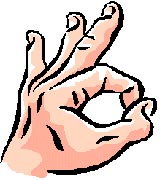 No one has a firm grasp as to why the middle
finger, the impedicus, is the longest finger on each hand. No one has a firm grasp as to why the middle
finger, the impedicus, is the longest finger on each hand.
This Latin word, in translation, means impudent, bold, and
immodest, but points us in the wrong direction in solving this
mystery, as the name, and the lewd gestures commonly made with
this finger, in no way explain its length.
The impedicus itself has a Latin name for being the
longest, which is mesaxonic, meaning middle axis. Mesaxonic
lends a little more assistance in the quest for an explanation
for the middle finger's length.
Evolutionary physiologists cling to the symmetry theory,
based upon their studies of the evolutionary reasons for the
inner workings of animals' bodies. Experts in this field hold
that the longer third finger is most likely a vestige of our
ancestors' paws, and state the need for balance as the primary
reason for its length.
 Their esteemed colleagues, evolutionary
morphologists, who study the evolutionary aspects of the shape
and of the structures of bodies, also adhere to the theory of
symmetry, but tack an additional aspect onto this theory, one
they refer to as the "geometry of closing." The geometry of
closing is merely scientific jargon for the fact that when the
hand closes to form a fist, all fingers touch the palm of the
hand at the same time. This way, when they grasp an object,
they all share the work equally. Simply put, the fingers on
our hands differ in length, because this particular shape
works so well, and has done so for millions of years. Their esteemed colleagues, evolutionary
morphologists, who study the evolutionary aspects of the shape
and of the structures of bodies, also adhere to the theory of
symmetry, but tack an additional aspect onto this theory, one
they refer to as the "geometry of closing." The geometry of
closing is merely scientific jargon for the fact that when the
hand closes to form a fist, all fingers touch the palm of the
hand at the same time. This way, when they grasp an object,
they all share the work equally. Simply put, the fingers on
our hands differ in length, because this particular shape
works so well, and has done so for millions of years.
Anthropologists, in general, disagree with the balancing
act behind the theory of symmetry. Their underlying reason for
disputing this theory is that, in their studies of human
evolution, they have encountered other primates, man's
closest, hairiest relatives, who have longer fourth fingers.
Anthropologists, however, do not pose a counter theory to the
most commonly held one. Until they do, the theory of symmetry
wins hands down! |
|